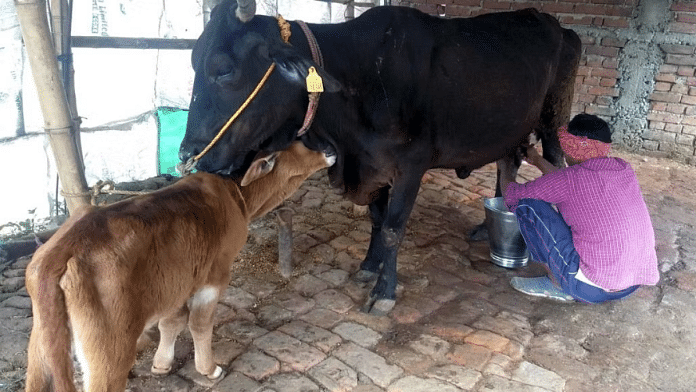New Delhi: The rights of cows and the anti-caste movement aren’t usually spoken about in the same conversation.
“How do you intervene in the dairy space as an Indian Brahmin?” asked Yamini Narayanan, author of the new book Mother Cow, Mother India: A Multispecies Politics of Dairy in India, at the launch event. Writing the book led the animal-rights researcher to confront her own caste identity. In an India where cow protectionism is promoted as a Hindu nationalist project that goes against Muslims, Christians, and Dalits, the author said: “I was constantly facing this conflict of being caricatured.”
But even as the worship of the cow peaks politically and vigilantism rises, all isn’t well for the animal. Cruelty continues, said Narayanan, who smartly wove together the ongoing mistreatment of cows and the oppression of lower caste groups.
Also read: Jobless Haryana men have a new mission in Muslim hate. ‘They think cow protection…
Vegetarians no longer innocent
In taking on the dairy industry and the commodification of the cow, the book delves into several socio-cultural fault lines: A vegetarian diet is no more innocent of animal slaughter than a non-vegetarian one, and the so-called White Revolution hides a lot of blood with the abuse of oxytocin and the denial of milk to the calves. The animal is viewed prejudicially, Narayanan said, with only the purebred cow being sacred — opening up another sort of ‘caste system’. Buffaloes are over-represented in the dairy industry and surprisingly there’s no political outrage around it as against cow slaughter.
Narayanan’s ethnographic work shows us how violence is inherent to dairying and slaughter is an essential part of the milk production line. The milk we consume, often in sterilised and pasteurised packets and cartons, comes from the assembly line where the cow is made to hyperlactate. The calf is invariably separated from the mother and denied milk. If male, it is often starved to death and the veal is packaged for consumption, often for the export market.
But the entire dairy process is sentimentalised in India, showing these animals as mothers who are willingly bestowing these gifts on us.
“The more sacred you are, the more vulnerable you are,” Narayanan, who also teaches at Australia’s Deakin University, said.
She also said that there is a lack of popular respect and seriousness in the manner in which the animal rights movement is viewed in India. It is largely perceived as an elite, futile, “whitewashed” movement as the Jallikattu practice and protests in Tamil Nadu have shown.
The leather sector, meanwhile, depends almost entirely on Dalits and Muslims who do all the grunt work — the skinning and tanning upon which the production of the material hinges. In popular political mythology, beef is associated with Islam and dairy with Hinduism. The frame of the discourse, Mother Cow, Mother India says, is the bond between the Hindu citizen–child and the mother–cow–nation.
Bring intersectionality in
The overarching call in the book published by the anti-caste publisher Navayana was for intersectionality –– and for the seemingly disparate movements to work together.
“I think the animal movement and the anti-caste movement are probably some of our closest alliances. And we need to hear these politics together,” she said.
And that’s where a deeper inquiry into our seemingly innocent practices comes in.
“How do we look at food security, livelihood security, property security? How do we look at these and make them part of our animal rights?” asked Bharati Ramachandran, CEO of the Federation of Indian Animal Protection Organisations.
There was no clear answer. In fact, animal activism itself emerged as limited, unable to fight the battles it should. “The animal rights movement is tacitly complicit in cow vigilantism,” said lawyer-cum-activist Alok Hisarwala Gupta, an advocate for animals and LGBTQIA+ rights. He pointed to the activists’ silence in the face of lynchings of Muslims and Dalits that are carried out in the name of cow protection.
The atypical premise and the position of the book — between cow protection, an interrogation of violence, and Ambedkarite politics — is what captured many participants at the virtual event.
“The book’s really helped me see intersectionality as something achievable in India. Especially when I think about how animal rights have been put in conjunction with human rights in so many ways,” said Tara, an audience member.
(Edited by Humra Laeeq)



